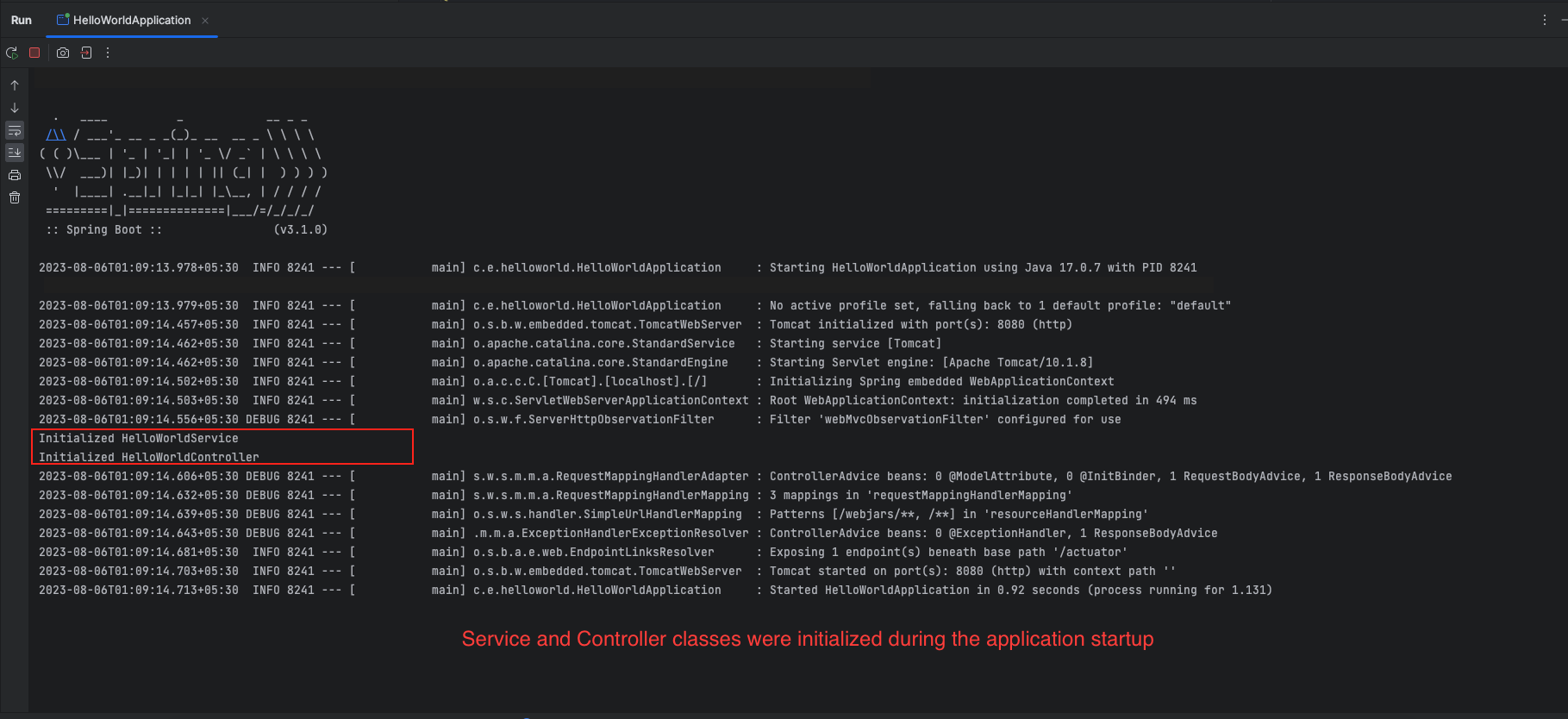Are you curious about Spring bean initialization? Delve into our comprehensive guide of Lazy Loading vs Eager Loading to uncover the ultimate strategy for achieving faster and more efficient applications.
Introduction
When developing applications using the Spring framework, one essential consideration is how to initialize beans within the application context efficiently. Spring provides two primary strategies for bean initialization: lazy initialization and eager initialization. Each approach has its advantages and use cases, and understanding them can significantly impact the performance and efficiency of your application.
What is Bean Initialization in Spring?
In Spring, bean initialization is the process of creating and setting up special Java objects, known as beans, when your application starts running. These beans are like building blocks that make up your application and perform different tasks. During initialization, Spring creates these beans and configures them with the required data and dependencies, just like setting up a team for a project with specific tasks and responsibilities. Once the initialization is complete, the beans are ready to be used by your application whenever needed, making it easier to manage and organize your code. This essential process ensures that all the necessary parts of your application are ready to work together seamlessly.
Understanding Lazy Loading
Lazy Loading(also known as Lazy initialization), as the name suggests, defers the creation of beans until they are explicitly requested. When the Spring container starts up, it doesn’t create all the beans immediately. Instead, it waits until the bean is needed in the application context. This approach can significantly improve application startup time and memory consumption, especially when you have a large number of beans and not all of them are required at the beginning.
Example:
@Lazy
@Service
public class HelloWorldService {
public HelloWorldService() {
System.out.println("Initialized HelloWorldService");
}
public String greetings() {
return "Hello World!!";
}
}@Lazy
@RestController
public class HelloWorldController {
private final HelloWorldService helloWorldService;
public HelloWorldController(HelloWorldService helloWorldService) {
System.out.println("Initialized HelloWorldController");
this.helloWorldService = helloWorldService;
}
@GetMapping("/hello")
public String sendGreetings() {
return helloWorldService.greetings();
}
}In this example, the HelloWorldController and HelloWorldService beans are annotated with @Lazy, which means they will be created and initialized only when the /hello endpoint is accessed for the first time, not during application startup. This lazy initialization helps optimize startup time and memory consumption by deferring the bean creation until they are actually needed.
Understanding Eager Loading
Contrary to lazy loading, eager loading(also known as Eager initialization) initializes beans during the application’s startup, regardless of whether they are immediately needed or not. Eager initialization ensures that all beans are available for use from the beginning of the application’s lifecycle. Eager initialization is the default behavior in Spring, and it is suitable for beans that are always needed at startup.
Example:
@Service
public class HelloWorldService {
public HelloWorldService() {
System.out.println("Initialized HelloWorldService");
}
public String greetings() {
return "Hello World!!";
}
}@RestController
public class HelloWorldController {
private final HelloWorldService helloWorldService;
public HelloWorldController(HelloWorldService helloWorldService) {
System.out.println("Initialized HelloWorldController");
this.helloWorldService = helloWorldService;
}
@GetMapping("/hello")
public String sendGreetings() {
return helloWorldService.greetings();
}
}In this example, the HelloWorldController and HelloWorldService beans are not annotated with @Lazy, which means they will be eagerly initialized during the application’s startup. This eager initialization ensures that both beans are created and their constructors are called immediately when the application starts. This approach is suitable for beans that are critical to the application’s functionality and need to be available right from the beginning.
Advantages and Disadvantages of Lazy Loading
Advantages
- Reduced Startup Time: Lazy initialization can significantly improve application startup time, especially in large applications with numerous beans. By delaying the creation of non-essential beans until they are needed, you can reduce the initial overhead.
- Memory Optimization: Since not all beans are created during startup, memory consumption is reduced. This can be particularly advantageous in scenarios where some beans are resource-intensive.
Disadvantages
- Potential Delay: Since beans are only created when requested, there might be a slight delay when accessing a lazily initialized bean for the first time. This delay could affect application responsiveness in specific use cases.
- Complex Dependency Management: Care must be taken when using lazy initialization for beans with dependencies on other beans. Managing these dependencies correctly is crucial to avoid unexpected behavior.
Advantages and Disadvantages of Eager Loading
Advantages
- Immediate Availability: With eager initialization, all beans are created and ready for use from the start of the application. There’s no delay when accessing beans, making it suitable for frequently used beans and critical components.
- Simplified Dependency Resolution: Eager initialization ensures that all dependencies between beans are resolved during the startup phase, reducing the risk of runtime errors due to unresolved dependencies.
Disadvantages
- Increased Startup Time: Eagerly initializing a large number of beans can lead to longer application startup times, especially in complex applications with many dependencies.
- Resource Overhead: If some beans are rarely used throughout the application’s lifecycle, eagerly initializing them may result in unnecessary resource consumption.
Use Cases and Examples of Lazy Loading
Example 1: Lazy Initialization in Database Connections
When dealing with a web application that connects to a database, lazy initialization can be beneficial. Not all pages or services may require database access, so postponing the creation of the database connection until needed can save resources.
Example 2: Lazy Initialization in Singleton Pattern
In the singleton design pattern, lazy initialization is often used to create a single instance of the class only when requested for the first time. This ensures that the instance is created only when required, reducing unnecessary overhead.
Use Cases and Examples of Eager Loading
Example 1: Eager Initialization in Configuration Settings
Configuration settings are frequently used throughout an application’s lifecycle. Eagerly initializing the configuration settings ensures that they are readily available for use at any time.
Example 2: Eager Initialization in Preloading Resources
In certain scenarios, preloading resources during application startup can improve performance. Eager initialization of such resources ensures they are readily accessible when needed.
Eager Loading vs Lazy Loading: A Comparison
| Sr. No. | Aspect | Eager Initialization | Lazy Initialization |
|---|---|---|---|
| 1 | Definition | Beans are created and initialized at application startup. | Beans are created and initialized only when they are explicitly requested. |
| 2 | Initialization Time | Occurs during application startup. | Occurs when the bean is first accessed by the application code. |
| 3 | Default Behavior | Default behavior in Spring. | Requires the @Lazy annotation to enable lazy initialization. |
| 4 | Application Startup Time | May lead to longer startup times, especially in complex applications with many dependencies. | Can significantly reduce startup time, especially when there are a large number of beans. |
| 5 | Memory Consumption | All beans are created and consume memory from the beginning. | Only beans that are requested will consume memory, leading to potential memory optimization. |
| 6 | Resource Intensity | Suitable for beans that are always needed throughout the application lifecycle. | Suitable for beans that are not always needed at the application’s startup or have resource-intensive operations. |
| 7 | Dependency Resolution | All bean dependencies are resolved during the application startup phase. | Dependencies on other beans may be resolved at a later stage when the bean is accessed. |
| 8 | Use Cases | Configuration settings, critical and frequently used components. | Resource-intensive beans, beans with infrequent usage, and scenarios where startup time is critical. |
Best Practices for Choosing Spring Bean Initialization Strategy
- Analyze Application Requirements: Understand the dependencies and usage patterns of your beans to determine whether lazy or eager initialization is more appropriate for each bean.
- Consider Resource Intensity: Take into account the resource requirements of each bean. Lazy initialization can be more efficient for resource-intensive beans that are not always needed.
- Optimize Startup Time: If startup time is critical for your application, consider lazy initialization for non-essential beans to reduce the initial overhead.
- Use Eager Initialization for Crucial Beans: For beans that are required throughout the application lifecycle, use eager initialization to ensure immediate availability.
- Mix and Match: You can use both lazy and eager initialization strategically to strike a balance between startup time and resource consumption.
FAQs
How can I enable lazy initialization for a specific bean in Spring?
To enable lazy initialization for a bean, you can annotate it with @Lazy. By default, beans are eagerly initialized.
Can I use both eager and lazy initialization in the same Spring application?
Yes, you can use both strategies in the same application. By selectively applying eager and lazy initialization, you can optimize the startup performance based on the specific requirements of each bean.
How does lazy initialization impact application performance?
Lazy initialization can lead to a slight delay when accessing a bean for the first time, but it can significantly improve startup time and memory usage, especially in large applications.
Is there a performance trade-off between eager and lazy initialization?
Yes, there is a trade-off. Eager initialization may result in longer startup times and higher resource consumption, while lazy initialization may cause slight delays when accessing beans for the first time.
Can I apply lazy initialization to all beans in my Spring application?
Yes, you can configure the Spring container to enable lazy initialization for all beans by setting the spring.main.lazy-initialization property to true in your application properties file.
Conclusion
In conclusion, understanding the concepts of eager and lazy initialization in the Spring Framework is crucial for building efficient and optimized applications. Choosing the appropriate initialization strategy should be based on the specific requirements and performance considerations of each bean in your application. By striking a balance between eager and lazy initialization and applying them strategically, you can enhance the overall performance and resource utilization of your Spring applications.
Learn More
Interested in learning more?
Check out our blog on troubleshooting Spring Boot Whitelabel error.




Add a Comment